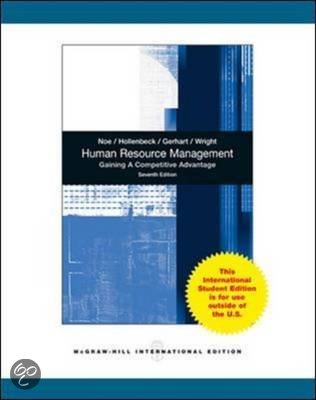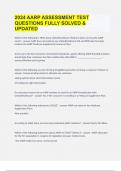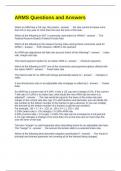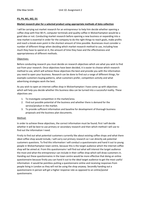Human Resource Management Summary:
Chapter 1: HRM; gaining a competitive advantage
HRM: policies practices and systems that influence employees’ behavior, attitudes and
performances.
Main practices of HRM consist of:
- Analysis and design of work
- HR planning: determining Human Resource needs
- Recruiting: attracting potential employees
- Selection: choosing employees
- Training and development: teach employees how to perform jobs and prepare them for
future.
- Compensation: rewarding in terms of salary, vacation etc.
- Performance management: evaluation of their performance
- Employee relations: creating a positive work environment
Responsibilities: Labor law compliance; keeping records of employees, testing employees
KSAO’s; compensation and benefits.
Outsourcing is the practice of having another company provide services. Reasons to
outsource HR practices include: cost savings; increased ability to recruit and manage talent;
improved HR service quality; protection of the company from potential law suits by
standardizing processes such as selection and recruitment.
Evidence based HR: showing that HR has a positive influence on the company’s bottom line
or key stake holders.
HR / Workforce analytics: using data from HR to make evidence-based HR decisions.
Big data: the merged information pool of HR, Corporate, financial statements etc.
Key take away: correct implementation of HR will improve the bottom line of the company
(Both revenue and costs)
3 systems to analyze data how learning contributed to success of the sales force:
1. Customer relationship management, include number and size of sales.
2. Learning and performance management, courses taken and self-evaluation of training
effectiveness and managers performance ratings.
3. Employee records, sales experience and hire date.
*(ways to check HR-related improvement in bottom line).
Senior HR role: developing and supporting company culture, employee recruitment,
retention and engagement, succession planning and designing overall HR strategy.
Junior HR role: handle transactions related to paperwork, benefits and payroll
administration, answering employee questions and data management.
Rated competencies for HR-employees:
o HR technical expertise/practice; apply principles of HR which contribute to success of
the firm.
, o Relationship management; ability to manage interactions with and between
employees.
o Consultations: provide guidance to stakeholders (within the firm) on a variety of
situations.
o Organizational leadership and navigation: give direction to processes within the
organization and gain support from stakeholders.
o Global and cultural practice / ethical practice: managing HR within and across
boundaries + integration of core values / integrity.
o Critical evaluation: evaluate / interpret information to make recommendations.
o Business acumen: understand business functions and metrics within the firm.
3 main challenges that will globally increase the importance of HR:
1. Sustainability challenge
2. Global challenge
3. Technology challenge
(The) Sustainability (Challenge): the ability of a company to meet its needs without
sacrificing future generations to meet their needs; triple bottom line economic; social;
environmental.
A company has 3 types of assets: financial (cash + securities); psychical (property, plant,
inventory); intangible:
Human capital, knowledge, education, work-related know-how.
Customer capital, customer relationships, brands, loyalty.
Social capital, corporate culture, management practices/philosophy.
Intellectual capital, patents, copyrights, trade secrets, intellectual property.
Increase intangible assets through acquiring knowledge workers: employees who own the
intellectual means of producing a product or service. To benefit from employees’ knowledge,
it is necessary to empower the employee (give responsibility and authority) and to consist of
a learning organization: a culture where employees are continually trying to learn.
Alternative work arrangements are employees with temporary contracts or are independent
(ZZP). Both advantages for company and person; call up when needed / save costs, more
flexibility for employee. However, might be difficult to maintain corporate culture or work
quality.
Balanced scorecard is a measurement which shows the company’s performance from
internal and external perspective. It’s used to link HRM activities to a company’s business
strategy and to evaluate the extent to which the HRM function is helping the company to
meet its strategic objectives. Mostly relate to productivity, people and process.
Social responsibility is the public demand for a company to be socially, ethically and
environmentally responsible. Protect the planet can also save money.
Customer driven excellence, understanding what the customer wants and anticipate to its
needs, reducing defects and errors, meeting specifications and reduce complaints.
Customers who receive high-quality value are more likely to be repeat customers.
, Total Quality Management (TQM) a form of doing business relying on talents and
capabilities of labor and management to continually improve quality and productivity.
Improve quality through:
- Malcolm Baldrige award; ISO 9000:2000 (quality standards adopted worldwide); Six sigma
process (system of measuring, analyzing, improving and controlling processes till they meet
standards); lean thinking (process focusing on using less effort, time and equipment but still
meet customers’ expectations).
Company performance on the balanced scorecard is influenced by its labor force, which
consists of internal labor force (= current employees. The skills of internal labor force
determine need for training and development and effectiveness of reward system) and
external labor force (outsiders seeking employment).
Current challenges to the workforce demographics and diversity: average age of workforce
increases; workforce becomes more diverse in terms of gender, race and generations;
immigration will affect size and diversity.
Challenge for managers to deal with these changes, bottom line is to gain advantage from
the power of a diverse workforce.
Ethics: the fundamental principles of wright and wrong by which employees and companies
interact. To be considered ethical, managers must:
- HRM practices must result in the greatest good for the largest number of people.
- Employment practices must respect basic human rights (privacy, consent, free speech).
- Managers must treat employees and customers all equitably and fairly.
The global challenge:
Global companies are struggling to find and retain talented employees in emerging markets.
Challenge for managers to obtain the cultural understanding to attract, motivate and retain
talented employees. Tried to overcome with: cross cultural training; experience abroad.
Offshoring: exporting jobs from developed to less developed countries to, lower its labor
costs and because of availability of strong work ethic.
Reshoring: moving jobs from overseas to the US because: high shipping costs; fear of supply
chain disruption because of unstable country; quality concerns; customer preference for US
products; rising labor costs in the less developed countries; local safety / working conditions
might result in negative publicity.
The technology challenge:
HR information system (HRIS): system used to
acquire/store/manipulate/analyze/retrieve/distribute HR information. It can support
strategic decision making, provide data for evaluating policies etc.
Cloud computing: system that provides information technology infrastructure over a
network in a self-service on-demand model. Public cloud is on demand via internet, while
private cloud only is accessible by a single company.
High performance work systems maximize fit between a company’s social system
(employees) and technical systems. Computer integrated manufacturing requires employees
to work with sophisticated technical equipment.
Chapter 1: HRM; gaining a competitive advantage
HRM: policies practices and systems that influence employees’ behavior, attitudes and
performances.
Main practices of HRM consist of:
- Analysis and design of work
- HR planning: determining Human Resource needs
- Recruiting: attracting potential employees
- Selection: choosing employees
- Training and development: teach employees how to perform jobs and prepare them for
future.
- Compensation: rewarding in terms of salary, vacation etc.
- Performance management: evaluation of their performance
- Employee relations: creating a positive work environment
Responsibilities: Labor law compliance; keeping records of employees, testing employees
KSAO’s; compensation and benefits.
Outsourcing is the practice of having another company provide services. Reasons to
outsource HR practices include: cost savings; increased ability to recruit and manage talent;
improved HR service quality; protection of the company from potential law suits by
standardizing processes such as selection and recruitment.
Evidence based HR: showing that HR has a positive influence on the company’s bottom line
or key stake holders.
HR / Workforce analytics: using data from HR to make evidence-based HR decisions.
Big data: the merged information pool of HR, Corporate, financial statements etc.
Key take away: correct implementation of HR will improve the bottom line of the company
(Both revenue and costs)
3 systems to analyze data how learning contributed to success of the sales force:
1. Customer relationship management, include number and size of sales.
2. Learning and performance management, courses taken and self-evaluation of training
effectiveness and managers performance ratings.
3. Employee records, sales experience and hire date.
*(ways to check HR-related improvement in bottom line).
Senior HR role: developing and supporting company culture, employee recruitment,
retention and engagement, succession planning and designing overall HR strategy.
Junior HR role: handle transactions related to paperwork, benefits and payroll
administration, answering employee questions and data management.
Rated competencies for HR-employees:
o HR technical expertise/practice; apply principles of HR which contribute to success of
the firm.
, o Relationship management; ability to manage interactions with and between
employees.
o Consultations: provide guidance to stakeholders (within the firm) on a variety of
situations.
o Organizational leadership and navigation: give direction to processes within the
organization and gain support from stakeholders.
o Global and cultural practice / ethical practice: managing HR within and across
boundaries + integration of core values / integrity.
o Critical evaluation: evaluate / interpret information to make recommendations.
o Business acumen: understand business functions and metrics within the firm.
3 main challenges that will globally increase the importance of HR:
1. Sustainability challenge
2. Global challenge
3. Technology challenge
(The) Sustainability (Challenge): the ability of a company to meet its needs without
sacrificing future generations to meet their needs; triple bottom line economic; social;
environmental.
A company has 3 types of assets: financial (cash + securities); psychical (property, plant,
inventory); intangible:
Human capital, knowledge, education, work-related know-how.
Customer capital, customer relationships, brands, loyalty.
Social capital, corporate culture, management practices/philosophy.
Intellectual capital, patents, copyrights, trade secrets, intellectual property.
Increase intangible assets through acquiring knowledge workers: employees who own the
intellectual means of producing a product or service. To benefit from employees’ knowledge,
it is necessary to empower the employee (give responsibility and authority) and to consist of
a learning organization: a culture where employees are continually trying to learn.
Alternative work arrangements are employees with temporary contracts or are independent
(ZZP). Both advantages for company and person; call up when needed / save costs, more
flexibility for employee. However, might be difficult to maintain corporate culture or work
quality.
Balanced scorecard is a measurement which shows the company’s performance from
internal and external perspective. It’s used to link HRM activities to a company’s business
strategy and to evaluate the extent to which the HRM function is helping the company to
meet its strategic objectives. Mostly relate to productivity, people and process.
Social responsibility is the public demand for a company to be socially, ethically and
environmentally responsible. Protect the planet can also save money.
Customer driven excellence, understanding what the customer wants and anticipate to its
needs, reducing defects and errors, meeting specifications and reduce complaints.
Customers who receive high-quality value are more likely to be repeat customers.
, Total Quality Management (TQM) a form of doing business relying on talents and
capabilities of labor and management to continually improve quality and productivity.
Improve quality through:
- Malcolm Baldrige award; ISO 9000:2000 (quality standards adopted worldwide); Six sigma
process (system of measuring, analyzing, improving and controlling processes till they meet
standards); lean thinking (process focusing on using less effort, time and equipment but still
meet customers’ expectations).
Company performance on the balanced scorecard is influenced by its labor force, which
consists of internal labor force (= current employees. The skills of internal labor force
determine need for training and development and effectiveness of reward system) and
external labor force (outsiders seeking employment).
Current challenges to the workforce demographics and diversity: average age of workforce
increases; workforce becomes more diverse in terms of gender, race and generations;
immigration will affect size and diversity.
Challenge for managers to deal with these changes, bottom line is to gain advantage from
the power of a diverse workforce.
Ethics: the fundamental principles of wright and wrong by which employees and companies
interact. To be considered ethical, managers must:
- HRM practices must result in the greatest good for the largest number of people.
- Employment practices must respect basic human rights (privacy, consent, free speech).
- Managers must treat employees and customers all equitably and fairly.
The global challenge:
Global companies are struggling to find and retain talented employees in emerging markets.
Challenge for managers to obtain the cultural understanding to attract, motivate and retain
talented employees. Tried to overcome with: cross cultural training; experience abroad.
Offshoring: exporting jobs from developed to less developed countries to, lower its labor
costs and because of availability of strong work ethic.
Reshoring: moving jobs from overseas to the US because: high shipping costs; fear of supply
chain disruption because of unstable country; quality concerns; customer preference for US
products; rising labor costs in the less developed countries; local safety / working conditions
might result in negative publicity.
The technology challenge:
HR information system (HRIS): system used to
acquire/store/manipulate/analyze/retrieve/distribute HR information. It can support
strategic decision making, provide data for evaluating policies etc.
Cloud computing: system that provides information technology infrastructure over a
network in a self-service on-demand model. Public cloud is on demand via internet, while
private cloud only is accessible by a single company.
High performance work systems maximize fit between a company’s social system
(employees) and technical systems. Computer integrated manufacturing requires employees
to work with sophisticated technical equipment.








